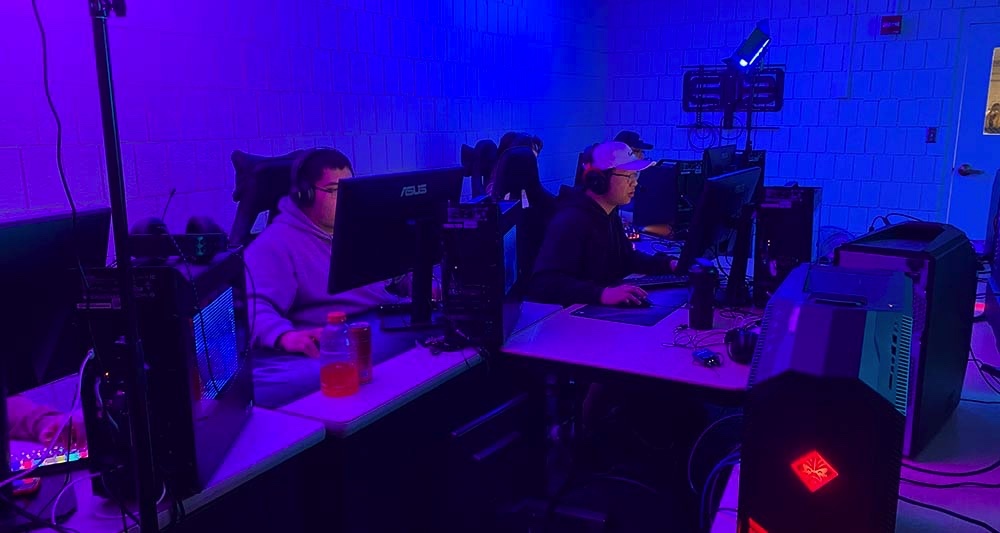Game on: The virtual reality of sports
Many students know what it’s like to cheer on the Aggies at traditional sporting events like basketball or football. But many students don’t know about another type of sport they’re missing out on — esports.
Esports is all about competitive video gaming and all anyone needs is a mouse, a computer and a virtual character.
The esports club at Utah State University has been around for more than four years and acts as a traditional sport with tryouts and varsity level teams.
A team can be created for any video game, as long as there is a big enough demand and enough players willing to compete. There is an average of five players per team, however, it varies depending on the esport.
USU currently has varsity teams for Valorant, Rocket League, Overwatch, Halo, League of Legends and a newly introduced Super Smash Bros. team.
And although many people think that gaming is individualized, gamers said it does take a team effort and communication.
For tournaments, the team sets up special blue and purple lights in their temporary arena to set the tone and when the game is on, the adrenaline kicks in and the room fills with intensity.
As the game goes on, players communicate with each other out loud with directions, and like other sports, they have plays and strategies designed to beat their opponents.
But there is still a big difference between breaking ankles on a basketball court and looting weapons through a screen.
Anson Ho, the esports coordinator at USU, said one benefit to being different from the typical idea of sporting events is anyone has the ability to play and at any time they want.
“Esports has its own variable because anyone can get their hands into it,” he said. “A lot of people have their own consoles at home, whereas not everyone gets the chance to play a football game.”
Similarly to students going to the Spectrum on a Friday night to watch Justin Bean dunk on rival Mountain West teams, anyone can cheer on their favorite gamers through the Twitch streaming service that allows anyone to spectate the game from their own phone.
Spectators aren’t just watching missions being accomplished through a monitor. USU and other colleges have broadcasting rooms where members of the club narrate the game live through Twitch.
This is just like hearing announcers for collegiate competitions or on TV for any professional sporting events.
This brings up the point that esports isn’t only a hobby, it’s an opportunity for advancement into a real career industry.
And with USU offering both gaming classes like web-game development and an esports minor, the university is striving to show the academic side of video games.
“There are about 80 different possible professions related to esports that students can go into, and our programs will help them get there,” said James Morales, the USU Student Affairs vice president.
Currently, over 325 colleges across the country have an esports club and the program continues to grow.
With this growth comes more viewership, which, according to Morales, is something USU needs to pay attention to so they can grow with the rest of the gaming world.
“At least 85% of millennials and Generation Z are gamers of some sort,” Morales said. “That translates to viewership that surpasses the number of viewers that watch Major League Baseball events, NBA events and soon is going to surpass the number that watch NFL events.”
But when claiming the viewership is relatable to the traditional sports on the big screen that many love and cherish, people may wonder how it even compares.
This raises a common controversial topic of what even qualifies as a sport.
Webster’s New World College Dictionary defines a sport as “requiring more or less vigorous bodily exertion and carried on, sometimes as a profession, according to some traditional form or set of rules.” By this definition, esports qualifies because although anyone can play, there are some things that need to be learned.
“Communication is by far one of the most important things in competitive gaming and being able to tell your teammates what’s happening on the field,” Ho said. “In real life you can pass a basketball and you’ll see exactly where they are and be able to throw that ball. In video games, you have to be able to visually explain where something is and how to describe that object.”
But according to Topend Sports, one requirement to be considered that esports doesn’t meet, is physical activity.
And along with that criticism, gamers face negative stereotypes like being lazy or having no social life.
“I think if you took the stereotypes away, a lot more people would play,” said Curtis Liu, the Valorant varsity captain.
But regardless of the thoughts of outsiders, as popularity for the esports club itself on campus increases, the need for a bigger and better arena becomes apparent.
“Everyone can have their own basketball but it’s not the same as having a space that’s dedicated to playing those games,” Ho said. “With an esports facility we would be doing the same thing, bringing students together in one place and having them form a network and game.”
One possible location for a new arena is the old USU IT building.
Morales is also helping the club expand into their own space and has even attended out-of-state conferences to learn more about the gaming world.
“We wanted to learn about the broader landscape. We have to partner with some of those folks out there that produce the gaming laptops or gaming chairs. They want to help us establish our arena,” Morales said.
The USU esports club competes in various tournaments throughout the year and holds tryouts for any student throughout the semester.
To find more information about the program, visit their website or follow their Instagram page @usuesports for highlights of games and upcoming events.
-Jacee.Caldwell@usu.edu
Featured photo by: Jacee Caldwell

